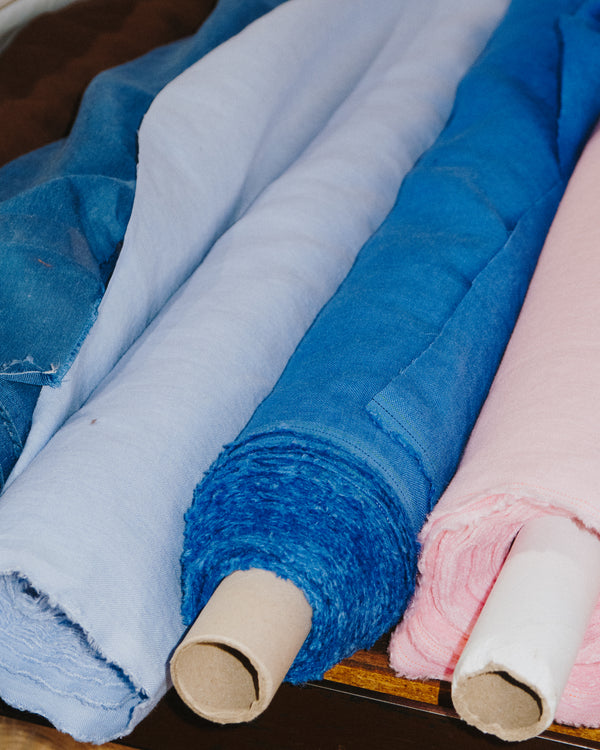II. MATERIALITY
OUR FIBRES
Fibres are raw materials that are converted into textile yarns and fabrics that are the base for sewing and knitting your clothing. Fibres can be briefly classified into three types: natural, regenerated, and synthetic, which can be used alone or blended to achieve certain qualities and characteristics. Our approach to fibre selection is natural and monofibre first as these fibres have a hopeful future in recycling and circular solutions. When we use a blended fibre we carefully select these for functionality and longevity of our garments.
NATURAL FIBRES
Natural fibres are derived from animal (protein) or plant (cellulose) matter, such as bast, skin, shells or seeds.
Conventional Cotton
The most popular fibre in the world, conventional cotton has been grown around the world for more than 6000 years. Conventional cotton requires high moisture levels to grow and a warm, dry season for the picking period. Picked cotton is then ginned to separate the soft and fluffy white fibres from the seeds before being spun and woven into fabric. High water consumption and chemical irrigation is the biggest concern for impact when it comes to conventional cotton, so we balance our use of conventional cotton with organic cotton where ever possible. We use conventional cotton for its durability, breathability and wearability year round.
Organic Cotton
Organic cotton has been promoted as an alternative to conventional cotton, with fewer synthetic agricultural chemicals and less water usage. The sustainability claims of organic cotton however are hotly debated in the industry - because organic cotton yields fewer fibres than conventional cotton, it requires more plants and more land to produce. Organic fibres also still undergo the processing and dyeing stage, which can also be very chemically intensive. We use organic cotton when we can confidently trace its claims (such as GOTS certified fabrics).
Flax (Linen)
Flax is one of the oldest and strongest natural fibres, dating back approximately 8500 years. Extracted from flax or linseed plants, it is a stiff and crisp fibre with a natural lustre and silky finish. Flax is grown quickly and easily, requires very few chemicals, and does not require irrigation during its cultivation. We use flax (or linen once it has been woven into fabric) for many reasons, including: durable yet silky touch, breathability and ability to keep you cool in summer, pill and insect resistant properties, softens with wear for comfort, biodegradable properties.
Wool
Wool is a natural protein fibre obtained from the shearing of sheep and the use of this fibre for human warmth and protection dates back over 10,000 years. The first Merino sheep were introduced to Australia in 1797, where the best merinos continue to be bred to this day. At JB we opt first for Australian Merino wool or RWS (Responsible Wool Sourcing) certified fabrics. We use wool for its properties of warmth, high elasticity, resistance to wrinkles, and biodegradability.
Silk
Often referred to as the “queen of fabrics”, silk is one of the oldest known luxury fibres. Silk is the only natural filament fibre and is sort, lustrous, shiny and smooth to the touch. Silk is produced by insects (silkworms) and there are concerns around animal welfare during the processing of this fibre. We use silk sparingly in our collections due to high costs, however it is an option available in our Bridal range due to its smooth drape, graceful flow, and tensile strength - stronger than cotton and linen, silk is one of the strongest natural fibres.
REGENERATED FIBRES
Regenerated (or semi-synthetic) fibres are derived from natural resources and go through a chemical process to transform them into:
Rayon, or artificial silk
Rayon was the first ever semi-synthetic fibre to be manufactured in France in the 1980s. It was created to be an affordable alternative to silk, wool, cotton, and linen and it can often be found blended with fibres to create a soft and silky feel. Variations of rayon that can be found in our garments include modal, lyocell, cupro and viscose. We predominantly use viscose in our silk-touch garments. Viscose is made from wood pulp or cotton linter and has a silky texture with a lower price point than silk itself. Viscose takes to dye really well and is how we achieve really vibrant colours in our collections. We acknowledge that the production of viscose can be very chemically intensive and therefore contributes to high levels of greenhouse gas emissions; this fibre is one of our least responsible fibres.
Lenzing certified EcoVero Viscose
We use and source Lenzing certified viscose whenever it is available. Lenzing fibers are obtained from certified, renewable wood sources in an ecologically responsible production process in compliance with high environmental standards. The non-profit environmental protection organization Canopy has consistently ranked Lenzing among the top viscose producers worldwide for their sustainable wood and pulp sourcing practices.
SYNTHETIC FIBRES
A chemical process called polymerization turns chemical compounds (similar to plastic, rubber, and coatings) into fibres
Polyester
While we do our best to avoid polyester (derived from nonrenewable petroleum), sometimes a small amount is blended into a fibre to help it retain shape or structure, ensuring your garment will be hard wearing and last you a really long time. You can find polyester in a very minimal number of our garments.
Spandex
Spandex, or elastane, is an incredibly stretchy fibre that is a by-product of petroleum. This fibre stretches to over 500% of its length and recovers to its original length immediately. We use spandex-blended fabrics in very small quantities to provide stretch to improve fit and shape retention.

OUR PACKAGING
Packaging at Jillian Boustred is an ever-evolving project as we research and learn new and better materials that ensure you receive beautifully packaged garments that leave a minimal footprint on our planet. All orders are shipped from our Chippendale studio with carbon neutral AusPost or GoGreen carbon neutral DHL courier options.
Compostable Mailer Bags
Our smaller orders are shipped in compostable mailer bags. Our mailer bags are made from 70-80% PBAT (a co-polymer that is completely compostable) and 20-30% PLA (cornstarch), and are waterproof to keep your order protected. In a commercial compostable environment, the mailer will break-down within 90 days. At home, it may take up to 120 days.
Cardboard Boxes
Our larger orders or any Bespoke orders may come packaged in a cardboard box. Made from 100% recycled kraft, our boxes are completely recyclable and compostable after use.
Swing Tags
Our swing tags and marketing collateral are printed with non-toxic inks on post-consumer recycled paper. Our swing tag cords are made from recycled plastic and organic cotton thread.
Tissue
All orders are carefully wrapped in our tissue paper which is made from FSC-certified, recycled paper and is fully home-compostable after use.
Stickers
We use branded paper stickers that are 100% recyclable and compostable, and made with FSC-certified materials and water-based inks.
Water-Activated Tape
Our water-activated tape is made from FSC-certified materials, and both home-compostable and curb-side recyclable after use. We use this to seal our boxes.
Shipping Labels
Our shipping labels are made with FSC-certified paper, 100% compostable and recyclable.

